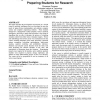Free Online Productivity Tools
i2Speak
i2Symbol
i2OCR
iTex2Img
iWeb2Print
iWeb2Shot
i2Type
iPdf2Split
iPdf2Merge
i2Bopomofo
i2Arabic
i2Style
i2Image
i2PDF
iLatex2Rtf
Sci2ools
SIGCSE
2006
ACM
2006
ACM
Image understanding as a second course in AI: preparing students for research
This paper describes the development and structure of a second course in artificial intelligence that was developed to meet the needs of upper-division undergraduate and graduate computer science and computer engineering students. These students already have a background in either computer vision or artificial intelligence, and desire to apply that knowledge to the design of algorithms that are able to automate the process of extracting semantic content from either static or dynamic imagery. Theory and methodology from diverse areas were incorporated into the course, including techniques from image processing, statistical pattern recognition, knowledge representation, multivariate analysis, cognitive modeling, and probabilistic inference. Students read selected current literature from the field, took turns presenting the selected literature to the class, and participated in discussions about the literature. Programming projects were required of all students, and in addition, graduate ...
Artificial Intelligence | Artificial Intelligence Education | Education | SIGCSE 2006 | Statistical Pattern Recognition |
| Added | 14 Jun 2010 |
| Updated | 14 Jun 2010 |
| Type | Conference |
| Year | 2006 |
| Where | SIGCSE |
| Authors | Roxanne L. Canosa |
Comments (0)

